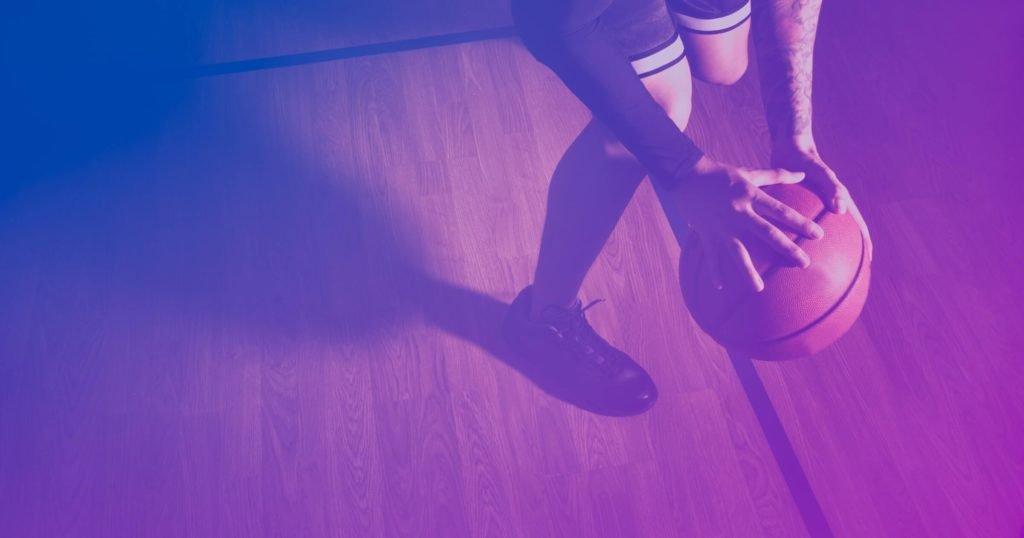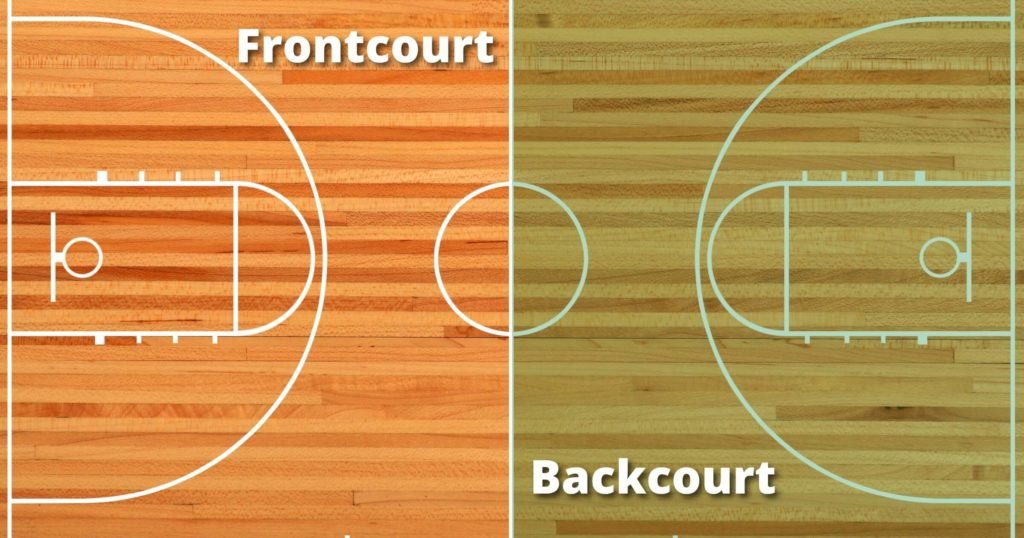Besides adding thrill and excitement, the rules on the backcourt speed up the game’s pace. It also gives both teams an equal opportunity to advance and score points.
But for the team that either unwittingly or deliberately violates the backcourt rule, it could give the opposing team a slight advantage to overtake them.
The backcourt is the side of the court that a team defends. It extends from the baseline to the mid-court line and contains the opponent’s basket. The term also refers to the team members positioned in that area—the point guard and the shooting guard.
What is the Backcourt in Basketball?
There are two definitions of the term backcourt: the literal area that a team defends and the team members mainly responsible for that side of the court.
In a basketball court, the backcourt is the side that a team defends. It is where the opponent’s basket is located. It covers the area from the baseline to the mid-court line.
When you hear someone say, “Oh, that team has a strong backcourt!” He’s not referring to that literal area on the hardcourt. Instead, he’s talking about the players of the offense positioned on that side.
In a five-player team, the term backcourt refers to two members who are the point guard and the shooting guard.
Why is it Called the Backcourt in Basketball?
As the name suggests, it’s located far back the offense’s designated basket. It’s where the play starts for the offense, but it’s on the other side of what matters more—the frontcourt where they aim to shoot baskets and score points.
Regarding the players, the point guard and the shooting guard are referred to as the backcourt because they’re mainly positioned and responsible for defending that side of the court.
What is the Backcourt Violation?

According to the rulebook, when the team takes the ball in possession, the backcourt players are given a specific time to advance the ball from the backcourt to the front. Depending on the league, this can be eight or 10 seconds.
Failure to get the ball past the midcourt line within the set timeframe will result in a penalty.
Also, once the offense has already brought the ball into the frontcourt, returning it to the backcourt is considered a violation.
What are the Frontcourt and Backcourt?

Both the backcourt and frontcourt areas have equal dimensions. Professional courts have a backcourt and a frontcourt, each measuring 47 feet long and 50 feet wide. A mid-court line separates these.
At the outset of this article, you know what backcourt is in basketball. Both the teams have a designated frontcourt and backcourt. But the positioning is relative to which team has the ball.
For the offense, the backcourt is the starting point from where they aim to advance the ball. The backcourt extends from the baseline up to the mid-court line.
The frontcourt is the farthest side and where the offense’s basket is located. It’s courtside where they attempt to shoot and score. It covers the area past the mid-court line.
Is Backcourt a Foul in Basketball?
Rules on backcourt are pretty stringent. Even so, no foul is called. However, it comes with a penalty.
What is the Penalty for Backcourt Violation in Basketball?
Since the backcourt violation in basketball is minor, there’s no foul called. There are no free throws awarded to the defense.
However, it results in ball turnover as a penalty. The opposing team will then get the possession and a chance to score.
What is an example of a Backcourt Violation?
The backcourt violation rule can be applied in two scenarios. A typical example is when a team player in possession of the ball stays more than the allotted timeframe in the backcourt.
Usually, the team in possession has eight to 10 seconds to cross the mid-court line. When they fail to do so, this is considered a backcourt violation. For example, the point guard takes more than 10 seconds dribbling the ball but fails to get past the mid-court line.
Next is the ‘over-and-back’. Suppose a player from the offense dribbles the ball past the mid-court line. Then, he takes the ball back to the backcourt either by dribbling back to that area or passing the ball to another player positioned on that side. This is a backcourt violation as well.
Another example of the ‘over-and-back’ violation is when a player from the offense steps on or over the mid-court line while dribbling the ball in the frontcourt.
What is not Considered a Backcourt Violation?
Sometimes, there will be scenarios in the game that might look like a backcourt violation, but if you take a closer look based on what the rulebook states, they’re not.
Here are a few notes to remember:
- It’s okay to pass in the backcourt as many times as you want because the ball hasn’t crossed the mid-court line yet.
- When a player from the opposing team deflects a pass from the frontcourt, picking the ball in the backcourt will not be considered a backcourt violation.
- Passing to a teammate in the backcourt is also not considered a violation during an inbounds pass.
5 Must-Know Tips to Avoid the Backcourt Violation
Now that we’ve learned what backcourt is in basketball let’s explore a few tips to avoid the backcourt violation. Here are a few basics.
1. Prepare a solid, well-thought game plan
Every team member must know his position’s responsibilities to advance the ball from backcourt to frontcourt.
2. Communication is key.
Excellent passing skills also depend on strong communication among team members. The point guard, acting as the team’s second coach, leads effectively, knowing who’s open to receiving a pass. Of course, other team members must be alert and agile as well.
3. Practice good dribbling skills to advance the ball within the set timeframe quickly.
Besides solid dribbling skills, speed is the key, whether it’s an eight-second or 10-second rule. Of course, during your practice, you need to think of the obstacles—the strong players of the defense. Practice how you’re going to get past them.
4. Focus on driving the ball into that basket.
When your eyes are focused on the prize, all there is to think about is to advance that ball from backcourt to frontcourt until it enters the hoop without fail.
5. Be mindful of the mid-court line.
Once you’ve crossed that line, there’s simply no turning back. It’s a small detail to remember but comes in handy every time.
Backcourt vs. Frontcourt Players
As detailed already, the question of what is backcourt in basketball may also refer to the players of a team positioned on that side of the court. Backcourt players include the point guard and the shooting guard.
Backcourt: Point Guard
The point guard is dubbed the ‘coach on the floor. This means that they lead the team while also on the go by studying positions and directing plays. Usually, they’re the best ball handler and passers.
While they’re also good at putting the ball in the hoop, they’re more focused on facilitating their team during the game. The rest of the positions, on the other hand, focus on scoring points.
Backcourt: Shooting Guard
Next up, we have the shooting guard. Shooting guards are typically the team’s best and most precise three-pointer. In addition, they’re fast and outstanding dribblers. Most shooting guards focus on preventing the other team’s best player from scoring points on the defense side.
Now let’s talk about frontcourt positions. These consist of three players: small forward, power forward, and center.
Front Court: Small Forward
Small forwards are versatile players. They’re swift and agile and can do everything on the hardcourt. Lay-ups, slam dunks, three-point shots—you name it.
They’re considered the second-best three-pointer on the team.
Front Court: Power Forward
Meanwhile, the power forward is positioned close to the basket. That’s why they need the speed and strength to guard big players of the opposing team who are also positioned in that area. They’re great at scoring points within close and mid-range.
Front Court: Center
Finally, we have the center. He’s usually the tallest and most significant guy on the team. Centers make great basketball screens, rebounds, and close-to-basket shots.
Conclusion
If your team performs well in the backcourt, you get a huge chance to advance the ball into the frontcourt, shoot baskets, and score points.
So, to avoid the penalty that a backcourt violation incurs, prepare a well-thought game plan, develop excellent communication with your team, practice strong, speedy dribbling skills with obstacles to overcome, and always be mindful of the rules, and focus on the prize.
Go ahead and drive that ball into the hoop!
Read these next:

3 thoughts on “What is the Backcourt in Basketball: Term and Violation”